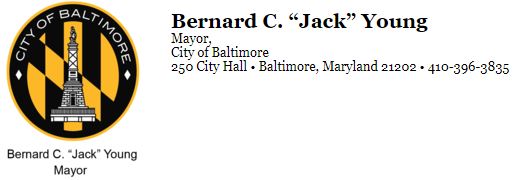[ad_1]

PRESS RELEASE
Mayor Young Releases COVID-19 Emergency Response Plan for People Experiencing Homelessness
BALTIMORE, MD. — Today, Mayor Bernard C. “Jack” Young released his COVID-19 Emergency Response Plan for People Experiencing Homelessness. This plan is an effort to mitigate risk for individuals in this vulnerable population. Mayor Young directed the Mayor’s Office of Homeless Services (MOHS) to work in partnership with homeless service providers and public and private agencies, to implement a range of prevention and response strategies to support individuals who are at particularly high risk of contracting communicable diseases and unable to self-isolate at home.
“The primary function of government is to protect the health and well-being of its residents, especially children, older adults and residents experiencing homelessness,” said Mayor Bernard C. “Jack” Young. “We must protect our homeless neighbors and mitigate their risk of infection the same way we do the rest of the city’s residents. In most cases, this means providing them access for testing and space to self-isolate, if needed. Our homeless neighbors are a part of this city and if we don’t protect them we leave our city exposed to greater risk.”
To date, MOHS is committed to the following five critical interventions:
1. Emergency Shelter Assessments and Testing
On March 20th, 2020, MOHS released guidance to the primary public emergency shelters. MOHS implemented this protocol to proactively identify potential COVID infections in emergency shelter environments as quickly as possible. It provides a process and resources for five of the public emergency shelters to assess residents for symptoms consistent with COVID, consult with a health care provider, receive a referral for testing, and be transported to an isolation site. It includes:
Shelter Client Triage Screening Tool: The emergency shelters will use this tool to proactively screen all shelter residents for symptoms consistent with COVID-19.
Telephonic Screening: After a positive initial screening, shelters will connect with a health provider to conduct a secondary telephonic screening.
COVID-19 Testing and Isolation: If the screening is positive, the individual will be referred for COVID testing and provided with transportation.
2. Hospital Discharge Practices
On March 17, 2020, MOHS released interim guidance for hospitals to ensure the proactive assessment of housing status upon discharge, prevent unsafe reentry into congregate living environments and unsheltered locations, and provide a safe alternative for isolation. Depending on the scenario, it includes discharge protocols to assess housing status and facilitate transfer to an isolation site or an emergency shelter bed as follows:
Discharge Protocol for Patients with Suspected or Confirmed COVID-19: For patients being discharged who are pending COVID-19 test results or are a confirmed case, before discharge, hospitals should complete a Housing Environment Screen to determine whether or not the individual will be able to self-isolate at home.
Discharge Protocol for Patients Experiencing Homelessness when COVID-19 is NOT Suspected: For patients being discharged from the hospital who are experiencing homeless when COVID-19 is NOT suspected, the hospital may coordinate discharge to an emergency shelter by contacting the Mayor’s Office of Homeless Services.
3. Isolation Sites
Baltimore City has secured multiple isolation sites to provide individuals experiencing homelessness and others unable to self-isolate with a safe alternative while awaiting test results and/or recovering from a COVID infection. Individuals identified through the emergency shelter assessment and hospital discharge processes are provided with transportation to a designated isolation site. Upon arrival, MOHS staff are completing an intake process with each person and maintain ongoing contact with each individual to assess ongoing needs during the isolation process.
The City of Baltimore will continue to evaluate community need and the availability of resources and modify isolation sites and supportive services.
4. Expanded Capacity for Social Distancing in Shelters
MOHS recognizes that with our emergency shelters filled to near capacity, the risk of communicable diseases spreading through this population is exceedingly high and there is no way to allow for shelter residents to practice the recommended level of social distancing. In response to this problem, MOHS plans to activate a social distancing shelter that will operate temporarily, at least until the COVID-19 health emergency has been contained.
5. Outreach to People Experiencing Unsheltered Homelessness
Homeless outreach teams have shifted to tactical operations to ensure individuals experiencing street homelessness are provided with critical supplies, including hygiene products, water, food, and guidance on COVID and available community resources.
Additional Planning
MOHS has released interim guidance and local and national resources to all homeless service providers and community partners. Many service providers have modified hours and services to mitigate the risk of exposure to staff and individuals experiencing homelessness. Comprehensive updates will be provided on a weekly basis and are made available on the MOHS website.
MOHS will continue to pursue additional opportunities to expand capacity within and beyond emergency shelters and provide updates as they are available.
Mayor Young expresses his sincerest gratitude to our front line workers and our partners that continue to collaborate with us as we battle this public health emergency.
[ad_2]
Source link


